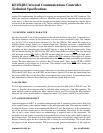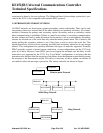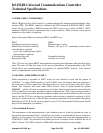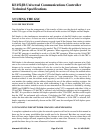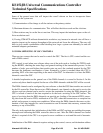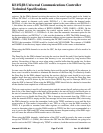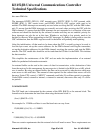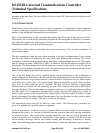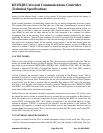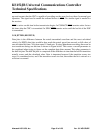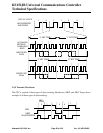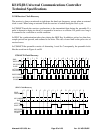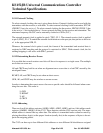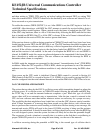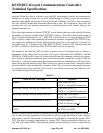
KS152JB Universal Communications Controller
Technical Specifications
Kawasaki LSI USA, Inc. Page 60 of 120 Ver. 0.9 KS152JB2
inquiry for the address check, a timer is also started. If the timer expires before the inquiry is
responded to, then that station assumes the address chosen is okay.
In the second procedure, an initializing station asks for an address assignment from the system.
This requires that some station on the link take care of the task of maintaining a record of which
addresses are used. This station will be called station-1. When the initializing station, called sta-
tion-2, gets on the link, it sends out a message with a broadcast address. The format of the mes-
sage should be such that all other stations on the link recognize it as a request for address
assignment. Part of the message from station-2 is a random number generated by the station
requesting the address. Station-2 then examines all received messages for this random number.
The random number could be the address of the received message or could be within the informa-
tion section of a broadcast frame. All the stations, except station-1, on the link should ignore the
initialization request. Station-1, upon receiving the initialization requests, assigns an address and
returns it to station-2. Station-1 will be required to format the message in such a manner so that all
stations on the link recognize it as a response to initialization. This means that all stations except
station-2 ignore the return message.
3.5.6 TEST MODES
There are two test modes associated with the GSC that are made available to the user. The test
modes are named Raw Receive and Raw Transmit. The test modes are selected by the proper set-
ting of the two mode bits in GMOD (M0 = GMOD.5, M1 = GMOD.6). If M1, M0 = 0,1 then Raw
Transmit is selected. If M1,M0 = 1,0 then Raw Receive is enabled. The 32-bit CRC cannot be
used in any of the test modes, or else CRC errors will occur.
In Raw Transmit, the transmit output is internally connected to the Receiver input. This is
intended to be used as a local loop-back test mode, so that all data written to the transmitter will
be returned by the receiver. Raw Transmit can also be used to transmit user data. If Raw Transmit
is used in this way the data is emitted with no preamble, flag, address CRC, nd no bit insertion.
The data is still encoded with whatever format is selected, Manchester with CSMA/CD, NRZI
with SDLC or as NRZ if external clocks are used. The receiver still operates as normal and in this
mode most of the receive functions can be tested.
In Raw Receive, the transmitter should be externally connected to the receiver. To do this a port
pin should be sued to enable an external device to connect the two pins together. in Raw Receive
mode the receiver acts as normal except that all bytes following the BOF are loaded into the
receive FIFO, including the CRC. Also address recognition is not active but needs to be per-
formed in software. If SDLC is selected as the protocol, zero-bit deletion is still enabled. The
transmitter still operates as normal and in this mode most of the transmitter functions and an
external transceiver can be tested. This is also the only way that the CRC can be read by the CPU,
but the CRC error bit will not be set.
3.5.7 EXTERNAL DRIVER INTERFACE
A signal is provided from the C152 to enable transmitter drivers for the serial link. This is pro-
vided for systems that require more than what the GSC ports are capable of delivering. The volt-



